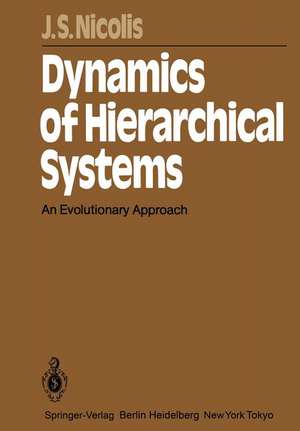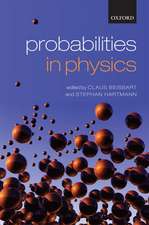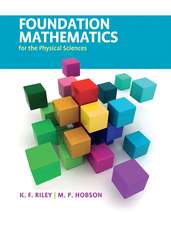Dynamics of Hierarchical Systems: An Evolutionary Approach: Springer Series in Synergetics, cartea 25
Autor John S. Nicolisen Limba Engleză Paperback – 13 dec 2011
Din seria Springer Series in Synergetics
- 15%
 Preț: 653.14 lei
Preț: 653.14 lei - 17%
 Preț: 430.21 lei
Preț: 430.21 lei - 17%
 Preț: 495.47 lei
Preț: 495.47 lei -
 Preț: 392.37 lei
Preț: 392.37 lei -
 Preț: 396.02 lei
Preț: 396.02 lei -
 Preț: 400.10 lei
Preț: 400.10 lei -
 Preț: 391.02 lei
Preț: 391.02 lei - 15%
 Preț: 641.38 lei
Preț: 641.38 lei - 18%
 Preț: 739.00 lei
Preț: 739.00 lei - 15%
 Preț: 645.60 lei
Preț: 645.60 lei - 15%
 Preț: 637.75 lei
Preț: 637.75 lei - 18%
 Preț: 727.31 lei
Preț: 727.31 lei - 20%
 Preț: 481.77 lei
Preț: 481.77 lei -
 Preț: 398.15 lei
Preț: 398.15 lei - 18%
 Preț: 742.97 lei
Preț: 742.97 lei - 15%
 Preț: 647.40 lei
Preț: 647.40 lei -
 Preț: 416.64 lei
Preț: 416.64 lei -
 Preț: 397.76 lei
Preț: 397.76 lei -
 Preț: 391.99 lei
Preț: 391.99 lei - 15%
 Preț: 644.49 lei
Preț: 644.49 lei -
 Preț: 386.99 lei
Preț: 386.99 lei - 20%
 Preț: 574.08 lei
Preț: 574.08 lei -
 Preț: 387.58 lei
Preț: 387.58 lei - 15%
 Preț: 533.53 lei
Preț: 533.53 lei -
 Preț: 396.02 lei
Preț: 396.02 lei -
 Preț: 390.25 lei
Preț: 390.25 lei -
 Preț: 392.37 lei
Preț: 392.37 lei -
 Preț: 396.40 lei
Preț: 396.40 lei -
 Preț: 408.16 lei
Preț: 408.16 lei - 18%
 Preț: 1116.09 lei
Preț: 1116.09 lei -
 Preț: 397.76 lei
Preț: 397.76 lei - 18%
 Preț: 971.64 lei
Preț: 971.64 lei - 15%
 Preț: 644.30 lei
Preț: 644.30 lei -
 Preț: 386.81 lei
Preț: 386.81 lei -
 Preț: 398.15 lei
Preț: 398.15 lei
Preț: 398.35 lei
Nou
Puncte Express: 598
Preț estimativ în valută:
76.23€ • 81.51$ • 63.55£
76.23€ • 81.51$ • 63.55£
Carte tipărită la comandă
Livrare economică 18 aprilie-02 mai
Preluare comenzi: 021 569.72.76
Specificații
ISBN-13: 9783642696947
ISBN-10: 3642696945
Pagini: 416
Ilustrații: XV, 397 p.
Dimensiuni: 170 x 244 x 22 mm
Greutate: 0.66 kg
Ediția:Softcover reprint of the original 1st ed. 1986
Editura: Springer Berlin, Heidelberg
Colecția Springer
Seria Springer Series in Synergetics
Locul publicării:Berlin, Heidelberg, Germany
ISBN-10: 3642696945
Pagini: 416
Ilustrații: XV, 397 p.
Dimensiuni: 170 x 244 x 22 mm
Greutate: 0.66 kg
Ediția:Softcover reprint of the original 1st ed. 1986
Editura: Springer Berlin, Heidelberg
Colecția Springer
Seria Springer Series in Synergetics
Locul publicării:Berlin, Heidelberg, Germany
Public țintă
ResearchCuprins
1. Introduction.- 1.1 What This Book Is About.- 1.2 Statement of the Problem.- 1.3 Some Preliminary Definitions of Complexity and Organization.- 2. Preliminaries from Nonlinear Dynamics and Statistical Physics.- 2.1 Symmetries and Conservation Principles.- 2.2 Instabilities at the Root of Broken Symmetries, Dissipation, and Irreversibility for Low-Dimensional (Not Statistical) Dynamical Systems.- 2.3 Elements of Statistical Physics and Their Relevance to Evolutionary Phenomena.- 2.4 Concluding Remarks.- 3. The Role of Spherical Electromagnetic Waves as Information Carriers.- 3.1 Radiation from Accelerated Charge in Vacuo. The Concept of “Self”-Force. Thermodynamics of Electromagnetic Radiation.- 3.2 Electromagnetic Wave Propagation in Dispersive Media and Lossy Media.- 3.3 Analysis of a Spherical Wave in Terms of Elemental “Rays”. The Mode Theory of Wave Propagation. Excitable Modes (Degrees of Freedom) in a Closed Cavity.- 3.4 The Entropy of Electromagnetic Radiation. Information Received by an Electromagnetic Wave Impinging on a Finite Aperture. Ambiguity of Perception.- 4. Elements of Information and Coding Theory, with Applications.- 4.1 Information Transfer and the Concept of Channel Capacity for Discrete and Continuous Memoryless Signals.- 4.2 Some Ideas from Coding Theory Instrumental in Minimizing Reception Error.- 4.3 Some Efficient Coding Algorithms for Source-Channel Matching and Single-Error Detection and Correction.- 4.4 Information Sources with Memory. Markov Chains.- 4.5 Specific Examples of Some Useful Channels and Calculations of Their Capacities.- 4.6 Modeling of Stochastic Time Series.- 4.7 Communication Between Two Hierarchical Systems Modeled by Controlled Markov Chains.- 4.8 Emergence of New Hierarchical Levels in a Self-Organizing System.-5. Elements of Game Theory, with Applications.- 5.1 Constant-Sum Games.- 5.2 Non-Constant-Sum Games.- 5.3 Competing Species.- 5.4 Survival and Extinction.- 5.5 Some Elementary Knowledge from Genetics: Selection and Fitness.- 5.6 Games Between Animals Adopting Specific Modes of Behavior (Roles). Concepts of Evolutionarily Stable Strategy.- 5.7 The Game of Competitive-Cooperative Production and Exchange. The Concept of “Parasite” at a Symbolic Level.- 5.8 Epidemiology of Rumors.- 6. Stochasticiky Due to Deterministic Dynamics in Three- or Higher-Dimensional Space: Chaos and Strange Attractors.- 6.1 A Reappraisal of Classical Statistical Mechanics. The Kolmogorov-Arnold-Moser Theorem.- 6.2 Dynamics in Three-Dimensional State Space (Three Degrees of Freedom). Steady States, Limit Cycles, Attracting Tori.- 6.3 Strange Attractors.- 6.4 Parameters Characterizing the Average Behavior of Strange Attractors: Dimensions, Entropies, and Lyapounov Exponents.- 6.5 A Possible Role for Chaos in Reliable Information Processing.- 6.6 Comments on the Effects of Internal Fluctuations and External Noise on the Stability Properties of Dynamical Systems.- 7. Epilogue: Relevance of Chaos to Biology and Related Fields.- 7.1 Computational Complexity.- 7.2 Towards a Dynamic Theory of Language.- 7.3 Concluding Remarks.- A. A View of the Role of External Noise at a Neuronal Hierarchical Level.- A.1 Introduction to the Problem.- A.2 Organization Through Weak Stationary-Amplitude Noise.- A.3 Relevance of the Model to Neuronal and Cognitive Organization.- B. On the Difficulty of Treating the Transaction Between Two Hierarchical Levels with Continuous Nonlinear Dynamics.- B.1 The Level Q of Partner I.- B.2 Homeostasis and Cross-Correlations.- B.3 The Level W of Partner I.- B.4 The Controller.- C.Noisy Entrainment of a Slightly Nonlinear Relaxation Oscillator by an External Harmonic Excitation.- C.1 General Description of the Model.- C.2 A Method for the Study of Entrainment.- C.2.1 Strict Entrainment.- C.2.2 Loose or “Jittery” Entrainment.- C.2.3 Pure “Free-Running” Oscillation.- C.2.4 Free-Running Oscillation.- C.3 Mathematical Treatment and Computer Simulation.- C.4 Behavior of the Oscillator Under an Applied Harmonic Excitation (Entrainment).- References.















